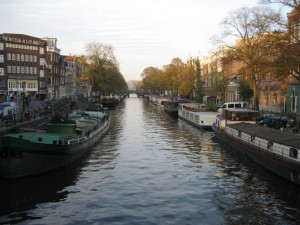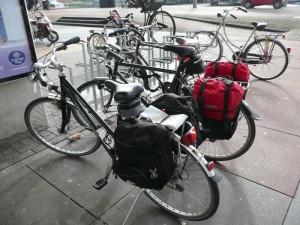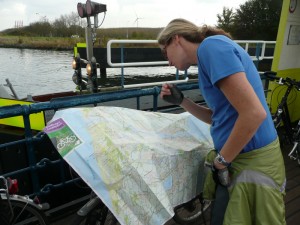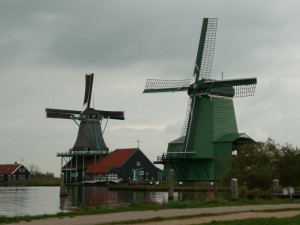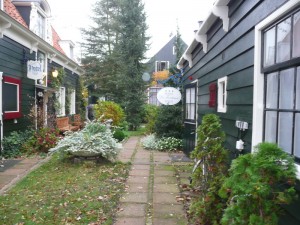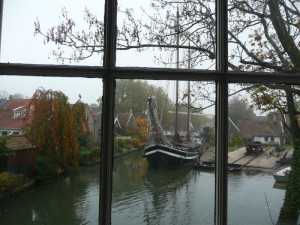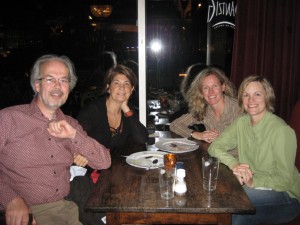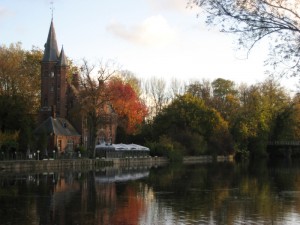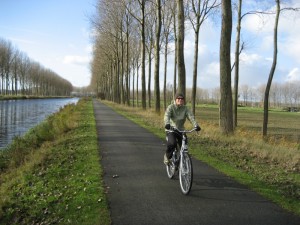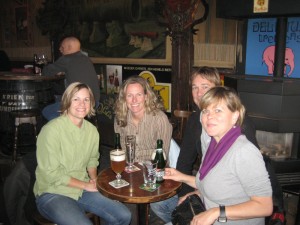Our trip began in Amsterdam, where the cycling is definitely not for beginners. It’s really quite nutty there, with cyclists flying through intersections left and right, no clear rhyme or reason as to why or when they choose to cross through. And no one wears helmets “because there are bike lanes”. This is true, but they are full of not only hundreds of other cyclists weaving their way in and out of traffic but also – and this is really quite mystifying – speeding scooters piloted by leather-clad teenagers who made sport of grazing elbows as they sped past.
Armed with this knowledge, Gina took me on a wild bike ride through the city to the Anne Frank House. She had had two days (while I was working) to figure out the crazy streets; I had had 2 minutes and was less than comfortable with simply darting out across a 6 lane intersection that included tram tracks with gaps just wide enough to fit one rental bike front tire, and, oh yeah, multiple other moving objects including buses, taxis, trams and pedestrians, as soon as any light in any direction turned green – didn’t matter if it was technically not our light. I decided it was best practice to follow the white-hairs through, for clearly they’d successfully navigated these streets for entire lifetimes.
After my work obligation was complete, we threw panniers on racks and headed out for a 3-day cycling trip, first riding our rented bikes from Amsterdam to the coastal town of Edam. By car, this would have been an 18 km journey. By bicycle and without a good map to get us out of Amsterdam, this was a 70 km pilgrimage. Part of those 70 km were intentional, as our aim was to get out of the city and into the beautiful farmland, but at least a dozen or so were not. The cycling roads were quite quiet and plentiful – no problem there – but the signage in Amsterdam? Not so much. Just when you thought you knew where you were going, you’d come upon a major roundabout, at which point all signage ceased and the rubbernecking began. It was during those moments that I once nearly bounced off a car rounding my way and Gina developed an oddly indecisive teetering style to her saddle dismounts. Those helmets might have come in handy after all.
Finally past the outskirts of Amsterdam, the route finding improved and we were pedaling through farmlands of cows and sheep and, on a few occasions, old idle windmills and older men in wooden shoes. As we settled into the blissful countryside, feeling confident and enthusiastic about our bicycle journey, the following words were unexpectedly uttered: “these damn canals are a problem”. We were on the wrong side of one – wrong being defined by the fact that the tiny ferry was tied to the other side, so close that we could have hit it with a single, well-aimed spit, but there was no captain in sight, no horn to sound, no rope to pull, no nothing to get that ferry motoring over to our side of the canal. Add a dozen more unplanned kilometers to get us to the nearest bridge and back again and we were on our way once more.
While speaking about unplanned kilometers, it’s probably a good time to mention why those might have mattered in the course of a day cycling through The Netherlands. Though some might argue that our steel touring bikes are heavy, Holland has definitely one-upped us in that regard. For example, my bike was nicknamed the Queen Victoria. She was about the same size and handled similarly – i.e., she needed quite a bit of room to come to a complete stop. This was because she must have weighed upwards of 45 pounds with all of the standard gear on these Dutch bikes – 12 pounds of locks so she wouldn’t get stolen, 8 pounds of handlebar so I could sit with my back as straight as the Queen’s, 10 pounds of extra large bicycle seat (squishy with springs is so ‘90s), 17 pounds of electrical equipment to run the headlight and taillight should one stay out too late in the Red Light District, 3 pounds of fenders and chain guard to protect your new suede boots and skirt (no cycling spandex here), and a 2 pound kickstand to keep the whole load upright when not moving forward.
Turned out those lights weren’t just for city driving. The sparsely populated areas we were cycling through were high on scenery but low on accommodations. As dusk fell that first day, we were without a place to sleep and starting to get a little concerned as to where we would lay our heads for the night. Edam was actually our destination of choice for the next day, but it turned out to be our only option for miles around. Armed with Rick Steves and international cell service, we called ahead, found a room, switched on those 17 pounds of electrical gear, and pedaled into the dark night and distant lights of town.
Edam was indeed super cute and became our home base for the next two nights. It was there that we learned that Europeans do not take dinner leftovers home with them. Now typically, this is easily understood, as the portions here are not super-sized like they are back home. But at dinner one night, we were served way more food than was consumable in one sitting. Gina, a fan of cold meat leftovers on long bike rides (call it a quirk), asked the waitress if Europeans ever took home doggie bags. With a funny look on her face – let’s call it surprise mixed with a hint of disgust – she explained to us that this is generally not done or, in the rare case that it is, it is definitely for THE DOG. Not to be deterred, Gina did secure our leftovers that night. We carried them back to our hotel as gracefully as delivered – not in a foil swan but in a bucket fit for Fido.
We spent the next two days biking the farmlands and canals north of Amsterdam, making our way back into its hectic core on Saturday. We had a dinner date that night with our Dutch friends Leo and Margreet, who we had met this past summer on one of our Iceland treks. We could have used our guide from that trek to help us find the restaurant, as Gina and I mistook its location for a rather seedy-looking little café on the next square over. Not seeming like Margreet’s style, we were pretty convinced we were in the wrong place, only where the right one was, we had no idea. Eventually, with Leo reeling us in via phone, we reunited for a lovely evening in the Nieuwmarkt district.
From Amsterdam we traveled by train to Brussels and Bruges, Belgium. Brussels was a bit of a bust – it was raining buckets and I caught a cold – but Bruges was the bomb. Its well-preserved medieval architecture and picturesque canals lined in fall foliage had Gina chanting “I can’t stand it!” at regular intervals, her way of describing the indescribably appealing.
Despite the sporadic cold, wet and windy weather there as well, we rented bikes once more and made some forays out into the Belgian countryside. When not on the bike, we foraged for waffles, chocolate, and over-the-counter cold medicine. It struck us as quite odd and a little bit funny that in a part of the world where a few days earlier we could have walked down a city street and legally purchased a doobie and a quickie, we had to find a pharmacist to buy a bottle of nose spray.
The night before we were to depart Bruges for Ghent, where we were invited to stay with another couple we met on one of our Iceland treks – Joel and Betty – we were informed by the hotel owner that there was a train strike planned for the next day. There would be no train to Ghent or any other city in or beyond the Belgium borders. “No problem,” said Betty, “we will come and get you.” And come get us they did. Who needs a train when you’ve got Joel behind the wheel of a speeding Mazda?
Betty and Joel treated us to a fabulous walking tour of their town, skirting the construction cranes and street craters (is there any European city out there that’s not in a constant state of restoration?) to explore the Gravensteen Castle and taste an authentic lambic Frambozen beer before returning us to their home in the countryside, where we met their two sheep, three goats, one chicken, one rooster, and a cat to lord over them all. Their hospitality continued to treat us into the next day, with a wonderful breakfast fit for any B&B, an invigorating trek around their neighborhood, and a quick tour of the richie-rich village of Sint-Martins, where the fall foliage was simply spectacular. It was the perfect way to end our trip.
